Culture in Steel and Concrete Canyons: A Conversation with Pasi J. Paltanen
I am walking down McCaul Street in Toronto on a dark and rainy Thursday. Around me people walk under umbrellas, their faces glued to the ever-present cellphones. Weaving through them are students of OCAD University, some of them lugging giant canvasses draped in tarps or garbage bags to protect them from the rain. They look excited, others worried, all move purposely and quickly. For today is the day when they will have their final critiques and evaluations (I will hear the term “crits” muttered many times today).
When I enter the university, I am hit by several smells: saw dust, paint, sweat. I move through crowded corridors searching for the Finnish born painter Pasi J. Paltanen. With the help of an admin, a teacher pushing an art dolly, and a student lugging a painting, I finally find Pasi having a conversation with two other students. He stands out amidst his fellow students. At forty-eight years, he is older than most of them. His stocky frame, tattoos, bald head and long beard make him look like he should be atop a motorcycle or sailing with Vikings, not graduating from an esteemed art institution. Pasi tells me he had his own crit just that morning, and after collecting coffee, we head up to his workspace in room 430 (the 4 Year Drawing and Painting Thesis Studio).
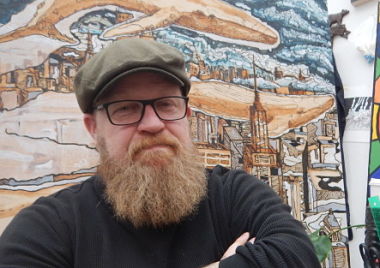 Pasi J. Paltanen. Photo: Todd H. C. Fischer
Pasi J. Paltanen. Photo: Todd H. C. Fischer
Room 430 is large, with workspaces set up for several students. The ceiling is high, and covered in windows. On a sunny day, I am told, the natural light is amazing. Pasi takes me to his spot, crowded with easels and framed illustrations. A quick scan of the space shows me streetscapes, portraits, images of bears and—dominating the space—a large painting of humpback whales swimming through the sky among high rises, titled, “Whale Road”.
We speak at first about his past and what caused him to pursue a career in art while approaching middle age. He was, he says, always artistic, and had actually attended OCAD before (in the 1990s). However, he said that his interests were not nurtured, he was told that art was not a real carrier, only a hobby. This led him to waste his time, not really doing anything, working as a bouncer, a doorman, a bodyguard, a chef and a computer animator.
A chance visit to the Ontario Gallery of Art led Pasi and his wife Jaclyn (a fibre artist) to walk past OCAD University (located next door). Jaclyn mentioned that she wanted to go back to school but didn’t know if they could ever afford it. Pasi encouraged her to apply, saying they would do whatever it took to make her dream come true. When she applied to OCAD U, so did he. He felt a great desire to finish what he had abandoned years ago.
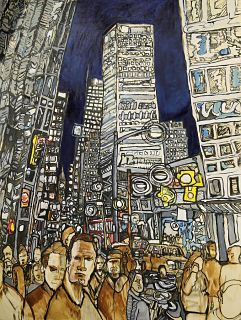 Pasi J. Paltanen, Front and Bay, Looking North, oil on wood panel, 4 x 3 feet. Courtesy of the artist
Pasi J. Paltanen, Front and Bay, Looking North, oil on wood panel, 4 x 3 feet. Courtesy of the artist
In 2016 Pasi and Jaclyn went on their honeymoon to Finland. He and his family had emigrated to Canada in 1978 for his father’s work (selling hockey sticks). It had been thirty years since Pasi had seen the land of his birth. Being there, he said, opened an awareness in him, he did not know existed. While he stressed that he is a Canadian, he found that being exposed to his roots filled the empty spaces within his identity.
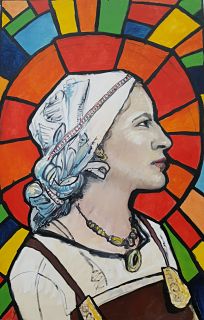 Pasi J. Paltanen, The Lady of Bearhall, oil on wood panel, 2 x 3 feet. Courtesy of the artist
Pasi J. Paltanen, The Lady of Bearhall, oil on wood panel, 2 x 3 feet. Courtesy of the artist
Visiting the Finnish National Art Gallery (the Ateneum) had a profound effect on his creativity. He thought that the Finnish folk tales and mythology, that he relearned on that trip, would dominate his art. What he found, however, was that it has combined with his experiences and inspiration of Toronto, creating its own mythology. This process, he says, is ongoing.
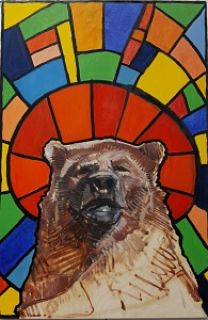 Pasi J. Paltanen, The Bear (a self portrait), oil on wood panel, 2 x 3 feet. Courtesy of the artist
Pasi J. Paltanen, The Bear (a self portrait), oil on wood panel, 2 x 3 feet. Courtesy of the artist
When asked about the juxtaposition of nature and the urban landscape, Pasi talked about his work in security. Working in this field means that he finds himself in the city very early in the morning, and very late at night. It is at these times, he says, when the clouds and light, the mist take on otherworldly proportions and truly fire his imagination. In fact, it was such a morning of heavy mist that inspired “Whale Road”, made him picture behemoths swimming through the air. He admits he always sees nature, even when it is not present.
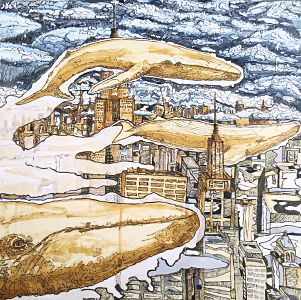 Pasi J. Paltanen, Whale Road, oil on wood panel, 4 x 4 feet. Courtesy of the artist
Pasi J. Paltanen, Whale Road, oil on wood panel, 4 x 4 feet. Courtesy of the artist
Pasi finds beauty everywhere. He tells me that a lot of people don’t like the city and don’t recognize its unique beauty, good vibration, a rich and blooming society and culture among the steel and concrete canyons. He feels fortunate that he can peel away the negativity, see and paint that beauty.
 Pasi J. Paltanen, King West Streetcar, oil on wood panel, 4 x 3 feet. Courtesy of the artist
Pasi J. Paltanen, King West Streetcar, oil on wood panel, 4 x 3 feet. Courtesy of the artist
Todd H. C. Fischer
*Pasi J. Paltanen is part of OCAD University’s annual Graduate Exhibition, May 3 – May 7, 2017, OCAD UNIVERSITY, 100, 113, 115 McCaul Street, Toronto. Hours: Thur – Fri, 9:30 a.m. – 8 p.m. Sat – Sun, 11 a.m. – 5 p.m.
